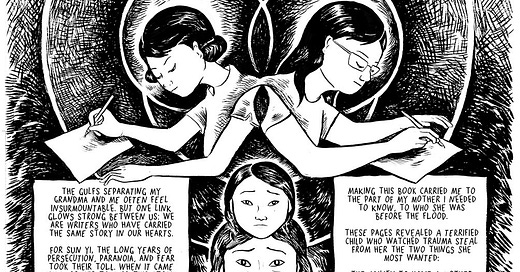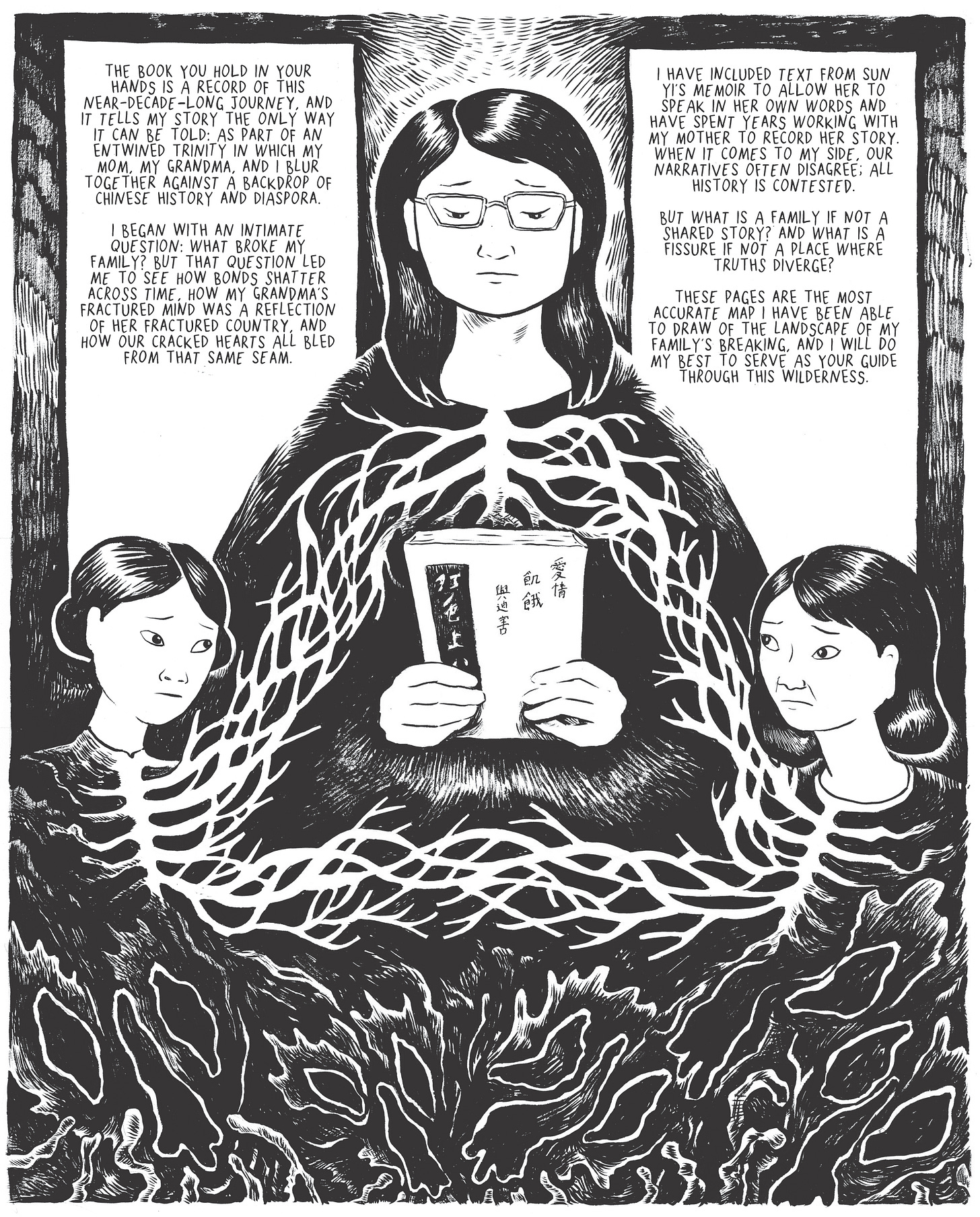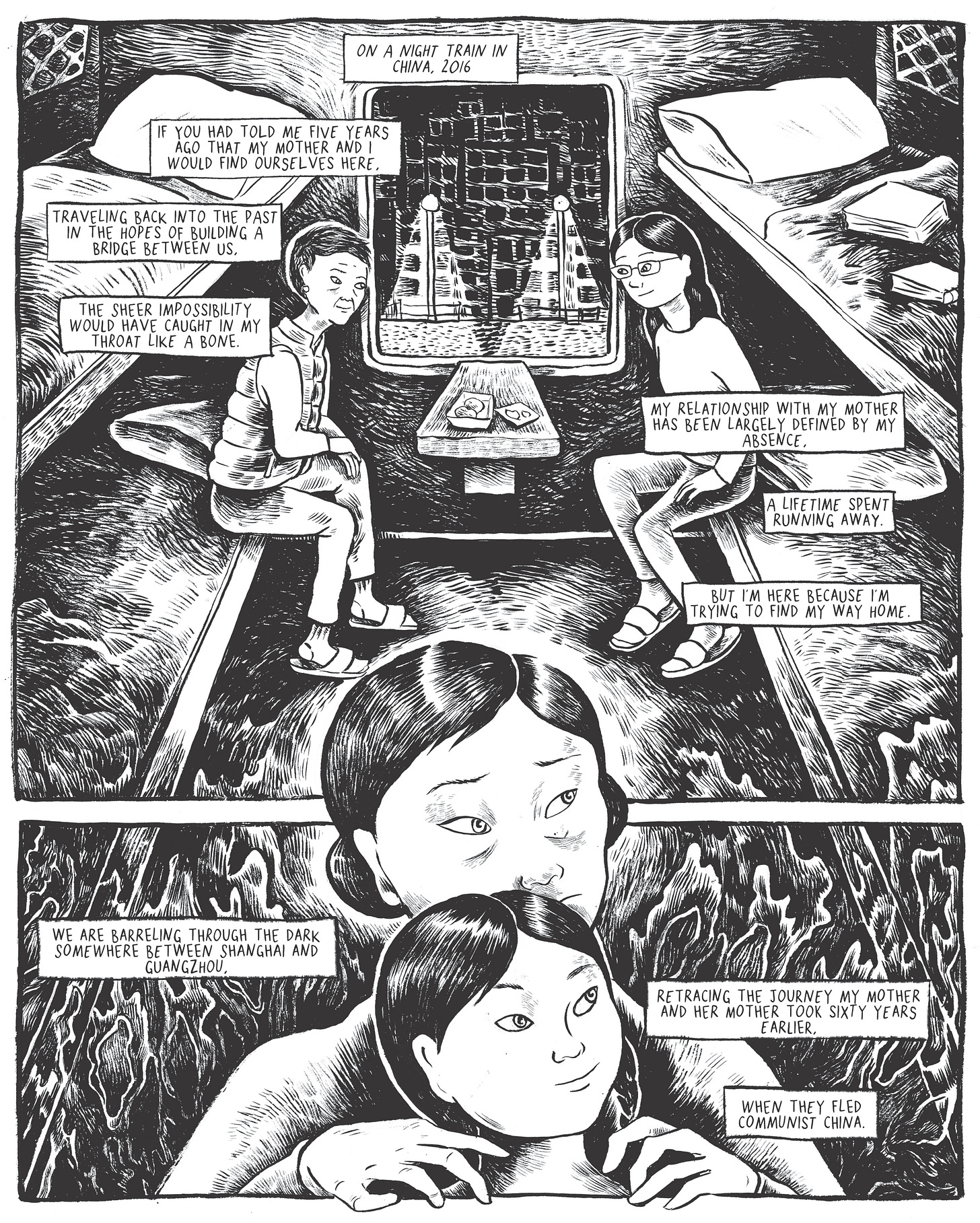Call up your book club—or a circle of friends, or join our comment thread—and a grab a copy of Feeding Ghosts, our featured book for a guided discussion and creative activity.
In our previous post, we had the pleasure of interviewing Tessa Hulls about her forthcoming graphic memoir, Feeding Ghosts. Hulls has spent the better part of a decade working on this memoir, and her work shows, from the intricately inked pages to the historical research. Feeding Ghosts is a story about culture, colonialism, belonging, trauma, love, mental illness, and identity. In it, we follow three generations: Sun Yi, who is Tessa’s grandmother, and a journalist in China before the Communist Revolution in 1949; Rose, Tessa’s mother, who must care for Sun Yi and adapt to life in Hong Kong and America; and Tessa, our author and guide, who embarks on a journey to better understand her family, the legacy of trauma that they carry, and to ultimately learn “how to stand closer to [her mother’s] pain” and her own.
History leaves its scars on Sun Yi, a Shanghai journalist who endures mental torture from the communist Chinese government only to lose her grip on reality. Sun Yi writes about her daring escape with her daughter, Rose, to Hong Kong, and then develops a kind of hypergraphia, writing and re-writing the story for the rest of her life, stuck in that moment of flight. After immigrating to America, Rose brings Sun Yi home and tends to her while also raising Tessa in a house marked by codependency, trauma, and mental illness. Grappling with this memoir becomes a way for Tessa to forge a new relationship with her mother.
Feeding Ghosts is written both chronologically and not. Rather, the story reads like a tetherball, swinging out broadly at first, but then spiraling in as it moves forward, tightening around the conflict. As the story swings along its path, it brushes against similar memories and moments in time, adding complexity to each instance, rewording and reworking how Tessa–and thus, how we as the audience–understand the history and the character’s place within it.
In order to create this graphic memoir, Hulls embarked on a variety and depth of research. She had her grandmother’s memoir translated into English so she could both read and study it. Hulls interviews her mother, applies for a grant to take them both to China and meet relatives, visit the places of the past, and even recreate the train ride that Rose and Sun Yi took when fleeing to Hong Kong. She also went to China and enrolled in Mandarin classes, using the afternoons to scout locations in Shanghai, look for artifacts from her grandmother’s memoir, and perform visual research. Hulls also studied Chinese history–and the ways that graphic memoirs can weave history into memoir, both in storytelling and page layout.
Here are some discussion questions for the book club:
Hulls writes, “children of immigrants face gaps when trying to reconstruct our parents’ pasts. We try to reverse engineer the missing pieces. But we shape them with our own cultural understandings. Thus arriving at conclusions that are simultaneously correct and completely wrong” (57). How do you see this navigated in the book? Do you believe it is worth telling someone else’s story even if you don’t fully know or understand them?
While this memoir is one you must carefully read, you cannot underestimate the role of visual art in telling this deeply personal and historical story. How do the illustrations complement the narrative, and what do they add to the reader's understanding of the themes? How does Hulls use expressive typography throughout?
Hulls uses a specific visual motif to depict the ghosts throughout her book. What effect do the ghosts have on the story when they appear? And, on the reader?
While sharing her grandmother’s Mao-era bestselling memoir, Hulls also deconstructs her grandma’s words–noting in one absurd case that Sun Yi wrote that her newborn daughter, Tessa’s mom, “was a blue-eyed, blonde-haired girl” when there is photographic evidence to the contrary. Why does Hulls reveal her grandmother’s artifice? What does this do to our understanding of Hulls’ own memoir?
Throughout the memoir, the idea of home and the experience of displacement are recurring themes. How do the experiences of Sun Yi, Rose, and Tessa leaving their homeland and adapting to new environments explore the concept of home? What does the memoir suggest about the meaning of home in the context of immigration and cultural dislocation?
Feeding Ghosts intertwines personal stories with political history. How does Hulls navigate the intersection of the personal and the political in her family’s story? How are our personal lives shaped by political landscapes–and how do they shape the political landscape?
Research as Repair Drawing Activity
In a way, Hulls is using research to repair her familial relationships, and Feeding Ghosts is a product of both this research and the repair that has happened.
For this drawing activity, choose a personal relationship from your past that you'd like to understand better. This could be a family member, a friend, or someone else significant in your life.
Research one aspect of this person's life, focusing on a different point in time from your own experience with them. Consider exploring the historical context, cultural background, or significant life events that may have shaped them. How might the setting, history, and societal norms of that time have influenced their behaviors, decisions, and relationship with you?
Visualize the person during the different point in time you explored. Imagine their surroundings, what they might be wearing, and what they are doing.
Draw four panels. Each panel should capture a different aspect of the person's life based on your research. Use the details from your research to enrich each panel. This could include historical landmarks, fashion of that time, or objects that have personal significance to the individual. Consider including:
The setting or environment they were in.
Their job or a typical activity they engaged in.
Details of their clothing or personal style reflecting the era.
A meaningful interaction or moment that illustrates their character or your relationship with them.
Share your artwork and insights with others in your book club, or us!, explaining how this activity helped you understand the relationship more deeply.









i love memoir comics! always keeping an eye out for good ones 💜
Sounds so good, and important.